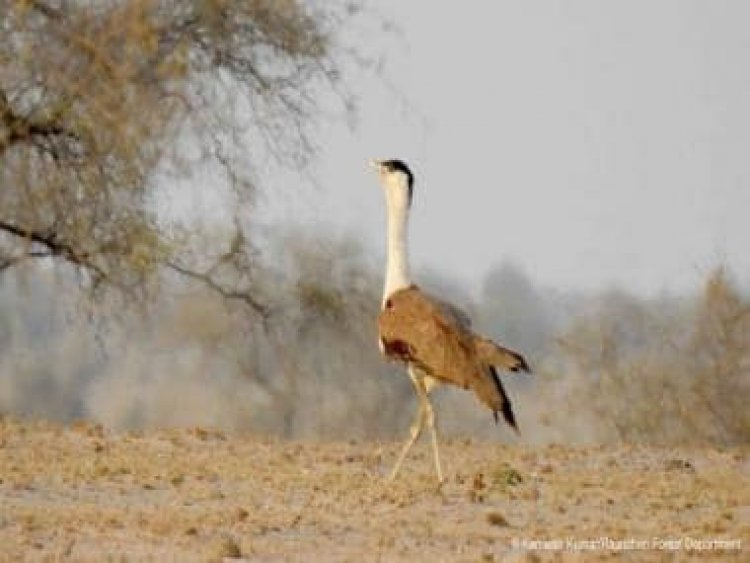Supreme Court wants to save the Great Indian Bustard: How the bird became critically endangered
Supreme Court wants to save the Great Indian Bustard: How the bird became critically endangered

The Great Indian Bustard needs our attention right away. Even the Supreme Court agrees. On Wednesday, the top court urged the Indian government to consider launching ‘Project Great Indian Bustard (GIB)’ similar to ‘Project Tiger’, a successful effort to conserve the Bengal Tiger. The GIB is critically endangered with its population dwindling to about 150.
“We had that Project Tiger, is it not possible to have some mechanism to bring focus on GIB like having ‘Project Great Indian Bustard’,” the bench of Chief Justice of India DY Chandrachud, Justice A S Bopanna and Justice V Ramasubramanian said.
‘Project Tiger’ is considered one of the most successful conservation programmes for a single species in the world.
#SupremeCourt hears petitions concerning the protection of the Great Indian Bustard, which is on the verge of extinction. SC had earlier constituted a committee to examine feasibility of under-grounding of over-head power lines to protect the bird.#GreatIndianBustard pic.twitter.com/8O8Qm69mm1
— Live Law (@LiveLawIndia) November 30, 2022
The court’s request came after it was informed about the deaths of some male and female bustards in the country. It was hearing a public interest litigation filed by conservationist MK Ranjitsinh, who had sought an intervention by the SC to take measures to save the species.
The Great Indian Bustard was once thriving in the country so much so that it was in a race to be crowned the national bird of India. It now faces extinction.
What is the Great Indian Bustard?
The Great Indian Bustard (GIB) is a very large grassland bird that is fighting for survival. It has been categorised as critically endangered by the International Union for Conservation of Nature (IUCN).
With the largest individuals weighing up to 15 kg, GIB is among the heaviest birds with flight. The size of an average bird from head to tail is between 92 to 122 cm and it has a life span of 15.6 years.
It’s a brown and white bustard with a black crown on its forehead. The males have whitish necks and underparts with a narrow black breast band. The females are smaller with greyer necks.
The GIB feeds on plants, crops, grass seeds, lizards and rodents.
Where is the bustard found?
The GIB was historically found across the Indian subcontinent – 11 western states in India and parts of Pakistan. Its stronghold was the Thar Desert and the Deccan Plateau, according to World Wildlife Fund, India.
However, now its habitat has largely shrunk. The bird is mostly seen in Rajasthan with a small fragmented population in Andhra Pradesh, Gujarat, Maharashtra, Madhya Pradesh and Karnataka. It is also found in Cholistan in Pakistan, which is adjacent to Rajasthan.
It is called ‘Son Chiriya’ in Madhya Pradesh ‘Godawan’ in Rajasthan and ‘Maldhok’ in Maharashtra. GIB is the state bird of Rajasthan.

Why is the GIB facing extinction?
Loss of habitat because of agricultural expansion, infrastructure development and hunting has seen a sharp decline in the population of the bustard. The birds are also occasionally poached outside protected areas. While hunting the GIB is banned in India, in Pakistan, it is killed for its flesh.
Another threat that the bird faces is from high-tension electric wires and electric poles. The GIB has poor frontal vision and hence can’t spot these dangers from afar. When it comes near, it is too heavy to change course and hence collides with wires and poles. According to the Wildlife Institute of India, at least 18 bustards die every year after flying into overhead power cables.
Also read: How protecting Great Indian Bustard can save other endangered species
What are the conservation efforts in India?
In 2015, the Centre launched a ‘Species Recovery Programme’ under which breeding centres were set up by the Rajasthan forest department and WII, where bustard eggs harvested from the wild were artificially harvested. A site for the establishment of a conservation and breeding centre for the GIB has been identified in the Kota district after consulting the forest departments of Rajasthan and Gujarat.
Conservation efforts are also being taken up in Maharashtra. The Centre has sanctioned Rs 33.85 crore for the habitat improvement and breeding of the bird.
Two years ago, the Ministry of Environment Forest and Climate Change (MoEFCC) and the Wildlife Conservation Society (WCS) India came up with a unique initiative — a “firefly bird diverter” for overhead power lines in areas where the bustard is found. These diverters installed on cables work as reflectors. Birds can spot them from a distance of about 50 metres and change their flight path, according to a report in The Hindu.
However, at a recent hearing, senior advocate Shyam Divan said that the Rajasthan government was not doing enough to instal bird diverters. Interestingly, Rajasthan chief minister Ashok Gehlot launched ‘Project GIB’ in the state in June 2013 saying that the bird was more vulnerable to extinction than the tiger.
The Madhya Pradesh government has also started to develop a reserved forest for the GIB in the Ghatigaon area of the Gwalior district. The bird’s eggs will be brought from Jaisalmer and hatched here.
In April 2021, the Supreme Court ordered that all power transmission lines in the core areas habitats in Rajasthan and Gujarat should be made underground.
Now once again the top court has stepped in. The CJI said, “Can we not bring a focused approach to save the beautiful and one of the largest birds by launching something like ‘Project GIB’?” He has asked Attorney General R Venkataramani to have a word with the environment ministry and come back with a response.
With inputs from agencies
Read all the Latest News, Trending News, Cricket News, Bollywood News,
India News and Entertainment News here. Follow us on Facebook, Twitter and Instagram.
What's Your Reaction?



























































